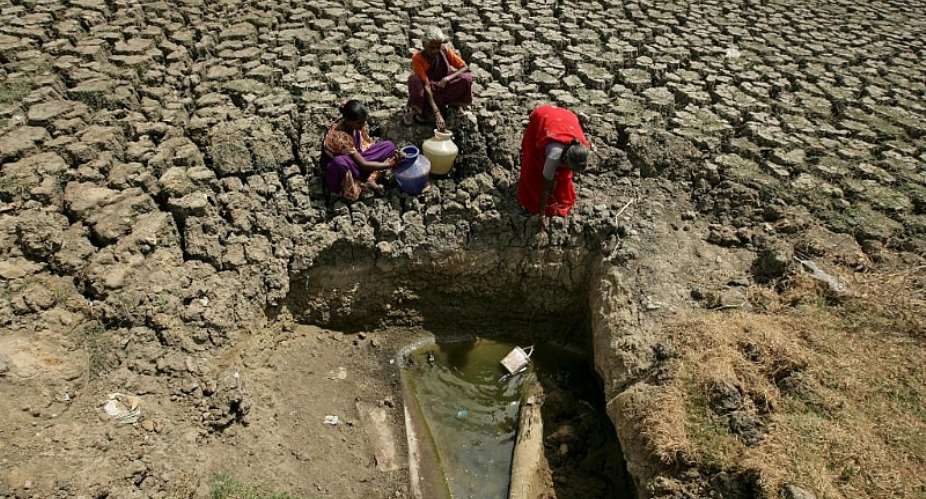A quarter of humanity faces an immediate risk of water scarcity sharply increased by global warming, a report by the US-based World Resources Institute (WRI) is warning.
People in 17 countries are already experiencing “extremely high water stress” that could lead to more “day zeroes” – when water taps run dry.
That term was first used by authorities in South Africa last year, when Cape Town came dangerously low to running out of water, which would have forced residents to queue for daily rations.
South Africa now faces “medium-high baseline water stress” according to WRI's interactive Aqueduct Water Risk Atlas, which also ranks drought risk and riverine flood risk across 189 countries and regions.
Water stress explained
So what exactly do we mean when we talks about water stress? The most common measure is the Falkenmark index, says Dr Simon Langan, a specialist with the International Water Management Institute – a research NGO based in Sri Lanka.
When water supply drops below 1,000 cubic meters per person, people face scarcity. “Absolute scarcity is when people have access to less than 500 cubic metres of water per year,” Langan says.
This new data warns us that almost 25 percent of the world's population is using up most of its water resources every year, which means that even a small drought, made more likely by climate change, could have dangerous consequences.
Countries with the worst shortages are Qatar, Israel and Lebanon, while the water-stressed regions are Gaborone and Jwaneng in Botswana and Badghis in Afghanistan. Overall, the most affected places on earth are the Middle East and North Africa.
While 1.8 billion people today are at immediate risk of water scarcity, fast-forward a decade and an estimated 470 million people will be in danger of thirst and dehydration, WRI figures show. By 2030, some 45 cities around the world will be experiencing acute water crisis.
Solutions lie in agriculture
Water use has been growing at more than twice the rate of population increase in the last century. While the news headlines are often preoccupied with drinking water, Langan says societies should be focusing their efforts on sustainably producing enough food to feed the world's booming population.
“That's what we need to think about: How are we growing our food? Are we growing it in the right places? Are we growing the right things? Are we producing the right types of meat? Are we overproducing meat? We hear about obesity increasingly. We need to think about all aspects,” he says.
“Water is perverse across all sectors of society and we really need to manage it and value it far more than we have done up until now.”





 This IMANI job no dey pap; the people you are fighting for are always fighting y...
This IMANI job no dey pap; the people you are fighting for are always fighting y...
 Prof. Naana Opoku-Agyemang has changed; you can see a certain sense of urgency –...
Prof. Naana Opoku-Agyemang has changed; you can see a certain sense of urgency –...
 MFWA Executive Director slams Akoma FM for engaging in ‘irresponsible’ media pra...
MFWA Executive Director slams Akoma FM for engaging in ‘irresponsible’ media pra...
 ‘Women must become millionaires too’ — Prof Jane Naana on establishment of Women...
‘Women must become millionaires too’ — Prof Jane Naana on establishment of Women...
 Some believe only in Ghanaian votes, not Ghana — Kofi Asare jabs politicians
Some believe only in Ghanaian votes, not Ghana — Kofi Asare jabs politicians
 Plan to make BEST sole aggregator of Sentuo Oil Refinery will create market chal...
Plan to make BEST sole aggregator of Sentuo Oil Refinery will create market chal...
 2024 elections: I can't have the man I removed from office as my successor — Aku...
2024 elections: I can't have the man I removed from office as my successor — Aku...
 2024 Elections: Immediate-past NPP Germany Branch Chairman garners massive votes...
2024 Elections: Immediate-past NPP Germany Branch Chairman garners massive votes...
 Gov’t focused on making Ghana energy self-sufficient, eco-friendly – Akufo-Addo
Gov’t focused on making Ghana energy self-sufficient, eco-friendly – Akufo-Addo
 April 25: Cedi sells at GHS13.74 to $1, GHS13.14 on BoG interbank
April 25: Cedi sells at GHS13.74 to $1, GHS13.14 on BoG interbank
